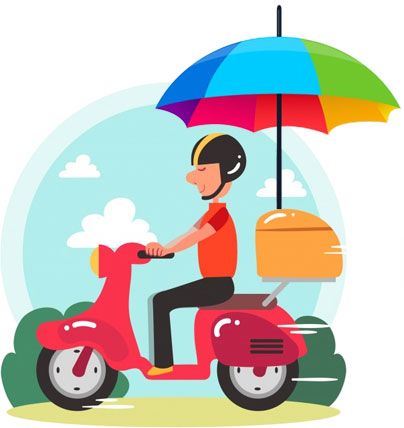The world is smart enough to buy electronics, garments, groceries, furniture and even dating online but many are still reluctant to
buy insurance online. It is due to several reasons like its not enough habitual for buyers to assure the safety of their documents online. This hesitation can be sensed well when it comes to buy even
two-wheeler insurance.
What make people think that buying TW insurance online isn’t safe?
1. Nobody’s there to guide you
Most common perception that makes buyers think that it is unsafe to
buy insurance online is the lack of guidance they sense while buying. Unlike traditional route where an advisor sits with you and gives options to customize your policy, in the online route nobody is there to guide you. But you can be your own guide by comparing the plans offered by all companies at a single platform like online insurance marketplaces and choose the best one for you in few clicks.
2. Risks involved with providing documents
Risk is the very factor that demotivates insurance seekers to
get deals online. Many are still reluctant to make payments online and provide copies of documents like RC book, identity proof etc. But there are many trusted sites and with proper due diligence you can ensure 100% safety in online transactions.
Steps to be taken to ensure safety
Buying
TW insurance online is never unsafe; however, one should take safety measures while purchasing two-wheeler insurance online.
Transparency means more credibility: With online purchasing of
two-wheeler insurance, transparency is the factor, which scores most determining the credibility of the site. Do not get lifted up with luring promises. Look out for transparency in their plans, details and policies.
Security of online transactions: Two wheeler owners
buying insurance online will have some safety concerns. It is mandatory to check SSL certification of the insurance website, which make the transactions legit and encrypted. SSL certified websites will have ‘https’ instead of ‘http’ web address or URL. Never use any public or unidentified wi-fi networks for money transactions to avoid security risks. Payments for
insurance premiums can be made using debit cards, credit cards, or net banking safely managed through secured gateways.
Avoid public Wi-Fi networks to make financial transactions: When transacting online, the internet connection you are using is a reason for data theft and thus a security risk. As a best practice, always make sure you use a secure personal Wi-Fi network while making any
online financial transactions.
Online insurance means more options to choose from, easy comparison between various plans, and saving time. With no broker or agent, buying insurance online helps you to save on premium. If you choose a credible website, with all
online financial transactions over an encrypted network, buyers need not worry about security.
 Top 10 Offline Two Wheeler Insurance Plans
Top 10 Offline Two Wheeler Insurance Plans
You must
buy an insurance plan for your two-wheeler to cover any damages due to accident, theft or loss of vehicle. According to the
Indian Road Safety Act and
Indian Motor Vehicles Act, it is mandatory to buy a
‘Liability Only’ plan for your two-wheeler to cover any damages to life, injury or property of a third party. There is also a
‘Comprehensive’ plan that gives additional security to owner and the vehicle.
Buying an insurance plan for your two-wheeler is easier said than done. There are so many insurance providers claiming to give you the best cover for your two-wheeler. There are offline and online insurance plan for your two-wheelers. Buying online is the most preferred option these days as it saves time and energy.
But offline methods too are preferred as you would like to visit the insurance branch, talk to a representative, take your time before choosing to buy the best insurance plan for your two-wheeler.
Here are the
top 10 offline insurance plans for your two-wheeler.
Bajaj Allianz Two Wheeler Insurance: Bajaj Alliance offers long term two wheeler insurance policy, with coverage up to 3 years. Long term policies help you to save money if in case of premium hikes or service tax hikes during that period. The company offers 24X7 claim assistance and offline as well as online renewal of policies.
https://www.bajajallianz.com/Corp/motor-insurance/long-term-two-wheeler-insurance.jsp
Reliance General Insurance: Reliance is one of the sought-after insurance providers for two-wheelers. It has over 2,100 network garages across India that provides free repair or replacement services. Besides, it also offers Rs 1,500 allowance on towing charges. Among its various benefits, it also provides no claim bonus, discounts on premium if anti-theft devices installed, and easy settlement of claims.
https://www.reliancegeneral.co.in/Insurance/Motor-Insurance/Two-Wheeler-Insurance.aspx
Tata AIG Motor Insurance: If you are looking for extra services than the normal insurance cover for your two-wheeler, then
Tata AIG Motor Insurance is the best plan for you. They not only provide
Liability only and Comprehensive plans, but also claim to compensate you for loss of your personal belongings that are kept inside the vehicle during the time of accident. Besides, it provides six-month warranty for accident repairs, and add-on covers are also available.
https://www.tataaiginsurance.in/motor-insurance/
ICICI Lombard Two Wheeler: ICICI is another big name in the world of two-wheeler insurance. It provides free servicing over 3000 cashless network garages across India. It offers the option of paying one-time premium. And if you are a member of
Automobile Association, you are eligible for discounts as well. It says in its website that it has issued over 11 million polices and settled over six million claims.
https://www.icicilombard.com/motor-insurance/two-wheeler-insurance#coverage
SBI Motor Two Wheeler Insurance: SBI needs no introduction and
SBI General Insurance offers customised two-wheeler plan. The two wheeler insurance offered by SBI General comes with customised pricing based on customer profile, and with special discount for vehicle owners between 25 years and 55 years of age. In addition to providing
Liability Only cover, it also offers a personal accident cover of Rs 1 Lakhs to the owner if the two-insured two-wheeler meets with an accident. It has a broad reach of over 56 cities and has a brand value second to none.
http://www.sbigeneral.in/SBIG/product/motor-two-wheeler-insurance
New India Assurance Motor Policy: New India has a strong global presence in more than 27 countries and is wholly owned by the government of India. It has made a niche for itself in the insurance market.
Two-wheeler insurance of new India comes under their broad offerings of
Motor Insurance, assuring a quick claim processing system. It provides both ‘Liability Only’ and Comprehensive insurance plan with a host of add-on covers.
http://newindia.co.in/Content.aspx?pageid=59
HDFC ERGO Two Wheeler Insurance: HDFC Ergo is an ISO certified insurance provider. The company offers customised long term two-wheeler insurance policy up to 3 years with NCB lock-in, thereby saves you from the hassles for renewing every year. They also offer additional discounts in the subsequent years and offers convenient both offline and online.
https://www.hdfcergo.com/motor-insurance/two-wheeler-insurance-policy.html
Royal Sundaram Two Wheeler Long Term Insurance: Royal Sundaram is a subsidiary of Sundaram Finance. The company offers long term two-wheeler insurance cover for two to three years on one-time payment and promises claim settlement within 10 working days. It offers unlimited liability for third party’s death or bodily injury claims. It also offers personal accident cover for pillion riders.
https://www.royalsundaram.in/two-wheeler-insurance.aspx
IFFCO Tokio Two Wheeler Insurance: IFFCO Tokyo Two Wheeler Insurance provides cashless claim facility across their garage networks across India for damages to your vehicle arising from accidents and natural calamities. It says in its website that its discounts on No Claim Bonus can go as high as 50 %. It also offers a cancellation policy and promises to repay the premium subtracting the pro-rate portion for the period the policy was in force.
https://www.iffcotokio.co.in/motor-insurance/two-wheeler-policy
Bharti Axa Two Wheeler Policies: Bharati Axa is a well-known insurance provider promising services across 2500+ cashless garages and claims 42 million policies issued. It has over 79 branches across India. The company offers discounts on premiums with
No-Claim Bonus, personal accident cover for all occupants and discounts on premium if anti-theft devices are installed in your vehicle. It also offers various add-on covers such as personal accident cover for pillion rider and zero depreciation cover.
https://www.bharti-axagi.co.in/two-wheeler-insurance?home
Before
buying an insurance plan, do make it a point to cover the benefits of different policies before choosing the best one meeting your requirements.



